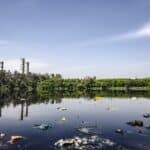Agricultural pollution is a growing concern that impacts our environment in various harmful ways. Agricultural activities and pollution are closely linked, as the methods used in farming often lead to contamination of air, water, and soil.
Understanding how these activities contribute to pollution is crucial for finding solutions that protect our planet. For example, the use of fertilizers and pesticides can harm water sources and affect human health.
Additionally, practices like over-irrigation and livestock farming release pollutants into the atmosphere. Therefore, it is essential to be aware of these issues to adopt more sustainable agricultural practices.
By recognizing the connection between agricultural activities and pollution, we can work toward reducing the negative impacts. This awareness can lead to better farming methods that benefit both the environment and humans.
What is Agricultural Pollution?
Agricultural pollution refers to the harmful effects caused by farming activities on the environment. When we talk about agricultural activities and pollution, we’re looking at how modern farming methods contribute to air, water, and soil contamination.
These activities often include the use of chemicals like fertilizers and pesticides, which can seep into the ground and waterways, causing widespread damage. Additionally, practices such as over-irrigation and intensive livestock farming release pollutants that harm the ecosystem.
Modern agriculture, though essential for food production, is a major source of environmental degradation. The widespread use of chemical inputs and heavy machinery has increased crop yields but at a significant cost.
For example, runoff from fertilized fields can lead to the pollution of rivers and lakes, creating dead zones where aquatic life cannot survive. This type of agricultural pollution is a serious threat to biodiversity and human health.
Understanding agricultural pollution is crucial for developing more sustainable farming practices. As the global population continues to grow, the demand for food will only increase, leading to even more intensive farming methods.
However, without careful management, these methods will further degrade the environment. Addressing agricultural pollution involves finding a balance between the need for food production and the protection of our natural resources. Sustainable practices can help reduce pollution while maintaining agricultural productivity.

Effect of Fertilizers and Pesticides from Agricultural Fields
Fertilizers and pesticides are widely used in agriculture to enhance crop yields and protect plants from pests. Fertilizers supply essential nutrients like nitrogen, phosphorus, and potassium to the soil, promoting healthy plant growth.
Pesticides, on the other hand, are chemicals designed to kill or repel pests that can damage crops. While these products are beneficial for increasing food production, they come with significant environmental risks. When not used carefully, these chemicals can cause serious pollution problems.
When fertilizers and pesticides are applied to crops, they don’t always stay where they’re intended. Rainwater can wash these chemicals off fields, allowing them to seep into the soil and nearby water systems.
This runoff can carry harmful substances into rivers, lakes, and groundwater, contaminating these important water sources. Over time, the buildup of these chemicals in the environment can lead to severe pollution, affecting both ecosystems and human health.
One of the most concerning effects of this runoff is eutrophication, which occurs when excess nutrients, particularly nitrogen and phosphorus, enter water bodies. These nutrients stimulate the growth of algae, which can form dense mats on the water’s surface, blocking sunlight from reaching underwater plants.
As the algae die and decompose, they consume oxygen in the water, creating “dead zones” where aquatic life cannot survive. This not only disrupts aquatic ecosystems but can also contaminate drinking water, posing a risk to human health.
Also Read: Effective Ways to Prevent Water Pollution
Air Pollution Due to Agricultural Activities
Agricultural air pollution comes from various sources, including the sprays used on crops, ammonia emissions from livestock, and dust from plowing. When farmers spray pesticides and herbicides, some of the chemicals drift into the air, contributing to air pollution.
Livestock farms, particularly those with large numbers of animals, release ammonia into the atmosphere, which can lead to the formation of fine particulate matter. Dust from plowing and other fieldwork adds to the problem, especially in dry regions where soil particles are easily lifted into the air.
The pollutants from agriculture can significantly affect air quality and human health. For example, ammonia emissions can combine with other pollutants to form fine particles that can be harmful when inhaled.
These particles can cause respiratory issues, especially in people with pre-existing conditions like asthma. Additionally, exposure to pesticide sprays can lead to various health problems, including headaches, dizziness, and even long-term effects like cancer.
Agriculture also plays a role in climate change through the release of greenhouse gases. Methane from livestock, particularly cattle, and nitrous oxide from fertilized soils are potent greenhouse gases.
These emissions contribute to global warming, which in turn affects weather patterns, crop yields, and the overall sustainability of agriculture. Therefore, reducing air pollution from agriculture is essential for protecting both the environment and human health.
Agricultural Water Pollution
Agricultural water pollution occurs when harmful substances from farming activities contaminate water bodies. This type of pollution is primarily caused by runoff from fields, where rainwater washes away fertilizers, pesticides, and animal waste into nearby rivers, lakes, and groundwater.
Irrigation practices can also contribute, as excess water can carry pollutants deeper into the soil and eventually into the water table. Additionally, chemical leaching, where pesticides and fertilizers seep into the ground, further contaminates water sources.
The effects of agricultural water pollution are far-reaching. Runoff carrying excess nutrients, like nitrogen and phosphorus, can cause eutrophication in water bodies. This process leads to the overgrowth of algae, which blocks sunlight from reaching aquatic plants.
As algae die and decompose, they deplete oxygen levels in the water, creating dead zones where aquatic life cannot survive. This not only disrupts ecosystems but also harms the fishing industry and other activities that depend on healthy water bodies.
Agricultural water pollution also poses a serious threat to human health. Contaminated water supplies can carry harmful chemicals and pathogens, leading to illnesses when consumed by humans.
Nitrate pollution, for example, is particularly dangerous as it can cause conditions like methemoglobinemia, or “blue baby syndrome,” in infants. Therefore, managing agricultural water pollution is crucial for protecting both the environment and public health.
Agricultural Soil Pollution
Agricultural soil pollution occurs when harmful substances are introduced into the soil, degrading its quality and fertility. This pollution is often the result of excessive use of fertilizers and pesticides, which leave behind residues that accumulate in the soil over time.
Heavy metals, often found in certain fertilizers and pesticides, can also contribute to soil pollution. Additionally, practices like over-fertilization can lead to nutrient imbalances in the soil, further degrading its health.
The impact of soil pollution on agriculture is significant. Polluted soil can lose its fertility, leading to reduced crop yields and lower-quality produce. The presence of heavy metals and pesticide residues can harm soil organisms, such as earthworms and beneficial microbes, which are essential for maintaining healthy soil structure and fertility.
Over time, the continued use of these harmful substances can lead to soil degradation, making it increasingly difficult to grow crops and sustain agriculture.
The long-term effects of soil degradation extend beyond agriculture. As soil quality declines, it becomes more prone to erosion, leading to the loss of topsoil, which is vital for plant growth. This erosion can also contribute to water pollution, as the soil particles carry pollutants into nearby water bodies.
Additionally, degraded soil can release stored carbon into the atmosphere, contributing to climate change. Therefore, preventing soil pollution is essential for maintaining the health of both agriculture and the environment.
Agricultural Runoff
Agricultural runoff occurs when rainwater or irrigation water flows over farmland, picking up fertilizers, pesticides, and other chemicals. This water then drains into nearby rivers, lakes, or oceans, carrying with it pollutants that can harm the environment.
Runoff is common in areas with heavy rainfall or where farmers use large amounts of chemicals to boost crop yields. As the water flows, it collects these substances and deposits them into water bodies, leading to serious environmental issues.
The environmental consequences of agricultural runoff are significant. One major problem is water pollution, which occurs when harmful chemicals from farms contaminate rivers, lakes, and oceans. These pollutants can kill fish, plants, and other aquatic life, disrupting the natural balance of ecosystems.
Additionally, runoff can lead to habitat destruction, as the chemicals can damage the quality of water and soil, making it difficult for certain species to survive. This loss of habitat can reduce biodiversity and weaken ecosystems.
Agricultural runoff also contributes to problems like algal blooms and dead zones. Algal blooms occur when excess nutrients, particularly nitrogen and phosphorus from fertilizers, enter water bodies. These nutrients cause algae to grow rapidly, blocking sunlight and depleting oxygen levels in the water.
As the algae die and decompose, they create dead zones, areas where oxygen levels are too low for most marine life to survive. This phenomenon not only harms aquatic life but also affects industries like fishing and tourism, which depend on healthy water bodies.
The Broader Environmental Impact of Agricultural Pollution
Agricultural pollution, in its various forms, has a broad impact on the environment. From air and water pollution to soil degradation and runoff, these pollutants contribute to environmental issues on a global scale.
Each type of pollution discussed—whether from fertilizers, pesticides, or livestock emissions—interacts with natural systems in ways that can be devastating to ecosystems and human health.
For example, polluted water from agricultural runoff can affect distant ecosystems, highlighting the far-reaching impact of these activities.
The effects of agricultural pollution on ecosystems and biodiversity are profound. Pollutants from farms can reduce the number of species in an area, weakening the ecosystem’s ability to function properly.
For example, when fertilizers and pesticides enter water bodies, they can kill off certain species of fish and plants, leading to a decline in biodiversity. This loss of species can disrupt food chains and reduce the resilience of ecosystems, making them more vulnerable to other environmental stresses like climate change.
Agricultural pollution also plays a significant role in climate change. The greenhouse gases released from livestock farming, such as methane, and the carbon dioxide from deforestation for agriculture, contribute to global warming.
Climate change, in turn, affects weather patterns, leading to extreme weather events that can further harm agriculture and the environment. Therefore, it is crucial to adopt sustainable agricultural practices that minimize pollution.
By reducing the use of harmful chemicals, improving waste management, and protecting natural habitats, we can mitigate the broader environmental impact of agricultural pollution and create a more sustainable future.
How to Prevent Agriculture Pollution?
Agricultural pollution is an environmental concern, and its prevention is necessary to protect ecosystems and human health. Here are effective ways to prevent it:
Reduce pesticide and manure use: Minimize the use of chemicals and animal waste to lower the risk of water and soil contamination.
Proper fertilizer management: Apply fertilizers carefully and in the right amounts to prevent excess nutrients from polluting water sources.
Prevent soil erosion: Implement practices like contour plowing and planting cover crops to keep soil in place and reduce runoff.
Manage livestock waste: Treat and store animal waste properly to prevent harmful bacteria and nutrients from polluting waterways.
Protect water bodies: Establish buffer zones with vegetation around rivers and lakes to filter pollutants before they reach water bodies.
Promote sustainable farming practices: Encourage crop rotation, organic farming, and other methods that reduce environmental impact.
Cover crops: Plant cover crops during off-seasons to improve soil health and reduce erosion and runoff.
Manage irrigation: Use efficient irrigation systems to reduce water wastage and prevent chemical leaching into groundwater.
Educate farmers: Provide training on sustainable practices and the importance of reducing pollution for long-term agricultural success.
Support government policies: Advocate for and comply with regulations that aim to reduce agricultural pollution and promote sustainability.
Conclusion
Agricultural activities and pollution are closely connected, leading to significant environmental issues such as air, water, and soil contamination. The harmful effects of fertilizers, pesticides, and runoff from farms highlight the need for urgent action.
These pollutants not only damage ecosystems but also pose serious risks to human health. Addressing agricultural pollution is essential for protecting our environment and ensuring sustainable food production. By understanding how these activities contribute to pollution, we can take steps to reduce their impact.
This includes adopting practices that minimize chemical use and manage waste more effectively. It’s crucial for farmers, policymakers, and consumers to work together in promoting environmentally friendly farming practices. By doing so, we can reduce agricultural pollution, protect our natural resources, and ensure a healthier future for all.








